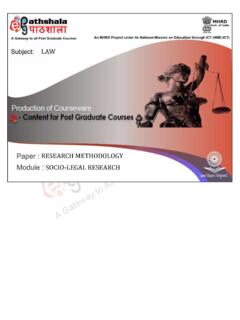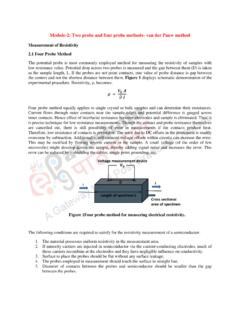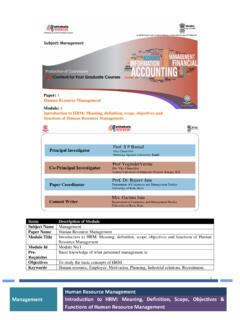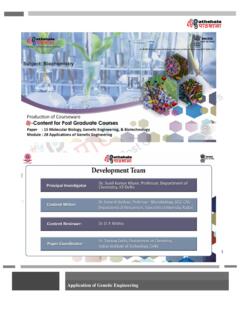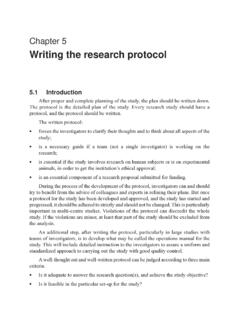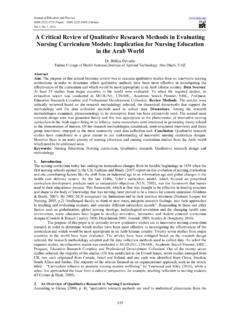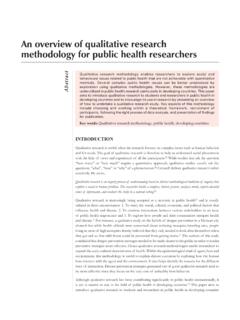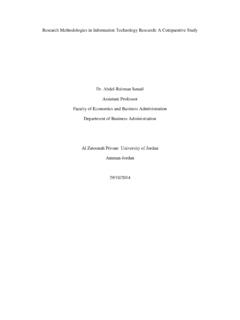Transcription of Research Methodology Data Analysis - INFLIBNET Centre
1 LAW. Research Methodology Data Analysis Role Name Affiliation Principal Investigator Prof. (Dr.) Ranbir Singh Vice Chancellor, National Law University, Delhi Co-Principal Investigator Prof. (Dr.) Bajpai Registrar, National Law University Delhi Paper Coordinator Prof. (Dr.) Bajpai Registrar, National Law University Delhi Content Writer/Author Prof. (Dr.) Bajpai Registrar, National Law University Delhi Ms Deepika Prakash National Law University Delhi Content Reviewer Prof. Department of Anthropology , University of Delhi DESCRIPTION OF MODULE. Items Description of Module Subject Name Law Paper Name Research Methodology Module Name/Title Data Analysis Module Id XIII. Objectives To study the concept and method of analyzing data in a Research Key words Data processing, tabulation, graphical representation, Analysis , statistics, statistical software, interpretation LEARNING OUTCOME.
2 This module will elaborate on the meaning and utility of data Analysis . It will provide a brief understanding of data processing, Analysis and interpretation in the Research process. The major focus of the module is to guide data Analysis -how to plan, collect and mange the data so collected in a quantitative Research for a meaningful Research outcome. 1. OVERVIEW OF THE STEPS IN Research . In every Research , following are the general steps involved: Defining problem Reviewing the available literature Formulation of hypothesis or Research questions Creating a Research design Collection of data with the help of various Research tools Processing of the data collected Analysis and interpretation of the data Report writing The present module seeks to understand how to handle the data which has been collected in the Research process in order to come up with some concrete findings in a scientific and systematic manner.
3 The data Analysis in this module refers to data collected only in a quantitative study. In such a study numerical data which has been gathered by the researcher presents quantities and variables which have been collected using tools such as structured observations, questionnaire and various tests. 2. MEANING OF DATA Analysis . In any Research , the step of Analysis of the data is one of the most crucial tasks requiring proficient knowledge to handle the data collected as per the pre decided Research design of the project. Analysis of data is defined by Prof Wilkinson and Bhandarkar as- A number of closely related operations that are performed with the purpose of summarizing the collected data and organizing these in such a manner that they will yield answers to the Research questions or suggest hypothesis or questions if no such questions or hypothesis had initiated the study.
4 According to Goode , Barr and Scales, Analysis is a process which enters into Research in one form or another form the very beginning It may be fair to say that Research consists in general of two larger steps the gathering of data, but no amount of Analysis can validly extract from the data factors which are not present. In his book on Research Methodology , C. R. Kothari explains that the term Analysis refers to the computation of certain measures along with searching for patterns of relationship that exist among data-groups. He quotes to further elaborate the concept as in the process of Analysis , relationships or differences supporting or conflicting with original or new hypotheses should be subjected to statistical tests of significance to determine with what validity data can be said to indicate any conclusions.
5 Hence, whether it is a qualitative or quantitative Research even if the data is sufficient and valid, it will not serve any purpose unless it is carefully processed and scientifically analyzed and interpreted. 3. DIFFERENCE BETWEEN DATA Analysis , PROCESSING AND. INTERPRETATION. The general understanding is that data Analysis and processing are one and the same. However a number of researchers and authors are of the opinion that both of them are two very distinct steps in the Research process where data processing leads to data Analysis . Lets us understand the difference between the two in more detail. Prof. John Gauing is of the opinion that processing of data refers to concentrating, recasting and dealing with the data so that they are as responsive to Analysis , while Analysis of data refers to seeing the data in the light of hypothesis of Research questions and the prevailing theories and drawing conclusions that are as amenable to theory formation as possible.
6 1. According to Francis Rummel, the Analysis and interpretation of data involve the objective material in the possession of the researcher and his subjective reaction and desires to derive from the data the inherent meaning in their relation to the problem. To avoid making conclusions or interpretations from insufficient or invalid data, the final Analysis must be anticipated in detail when plans are being made for collecting information. Data Processing Once the data is collected, following steps are taken to process the data into more measurable and concise manner: a. Editing In the stage of editing all the raw data that is collected is checked for errors, omissions sometimes legibility and consistency as well. This ensure basic standard in the data collected and facilitate further processing.
7 B. Coding Coding refers to the process of assigning numerals or other symbols to answers so that responses can be put into a limited number of categories or classes. Such classes should be appropriate to the Research problem under consideration. They must also be exhaustive ( , there must be a class for every data item) and also that of mutual exclusively which means that a specific answer can be placed in one and only one cell in a given category set. 2 Coding can also be pre or post. Pre coding meaning codes being assigned while the questionnaire or interview schedule is being prepared. In the case of post coding, codes are assigned to the answers after they are collected. c. Classification Once the data is collected it is to be divided into homogeneous groups for further Analysis on the basis of common characteristics.
8 D. Tabulation Tabulation is the process of summarizing raw data and displaying the same in compact form ( , in the form of statistical tables) for further Analysis . In a broader sense, tabulation is an orderly arrangement of data in columns and rows. Tabulation is essential because of the following reasons- 1. It conserves space and reduces explanatory and descriptive statement to a minimum. 2. It facilitates the process of comparison. 3. It facilitates the summation of items and the detection of errors and omissions. 4. It provides the basis for various statistical computations. 1 Dr. and Dr. Bajpai, Research Methodology : Data Presentation, p 151, APH. Publishing Corporation, ed 2012. 2 , Research Methodology - Methods and Techniques, P 123, new age international limited publisher, 2nd ed.
9 Tabulation can be done by hand or by mechanical or electronic devices. The choice depends on the size and type of study, cost considerations, time pressures and the availability of tabulating machines or computers. In relatively large inquiries, we may use mechanical or computer tabulation if other factors are favorable and necessary facilities are Tabulation may be a very effective way of making legal Research manageable, readable and understandable. Types of table There are generally two types of tables simple and complex. They are discussed following: (i) Simple table/ frequency distribution Under it , the different attribute are stated in the left hand column and the frequency or extend of occurrence of each of theses classed are written in another column.
10 In this three things are essential) the classes made must be mutually exclusive, b) the tabulation must have internal logic and order, and c) the class intervals must carefully and reasonably Following is an illustration of the same. Table 1- Univariate5. Age of the Frequency Percentage respondents Below 10 14 11-20 18 21-30 22 31-40 42 41-50 26 20. Above 50 8 Total 130 100. In the above table the only variant is age. (ii) Complex or cross table 3 Supra note 2. 4 Dr R. Kumar, Methodology of social Science Research , p223, Book Enclave , Jaipur, 2002. 5 , Research Methods, In a complex table, bi or multivariate are used. These have become more popular in the Research representation in recent years. Following is an example of the same. Table 2- Multivariate Income SEX Total (Rupees) Male Female Rural Urban Rural Urban Below 100 20 23 8 12 63.

